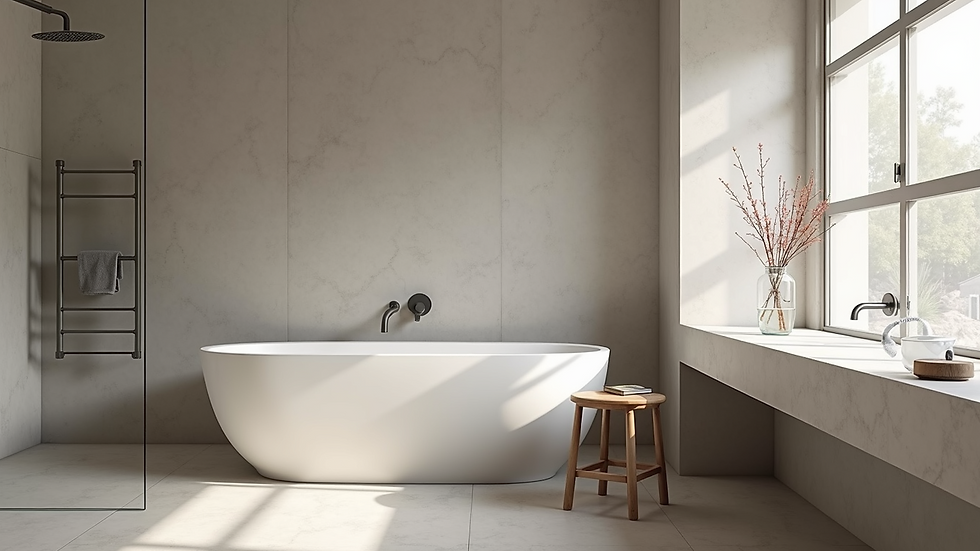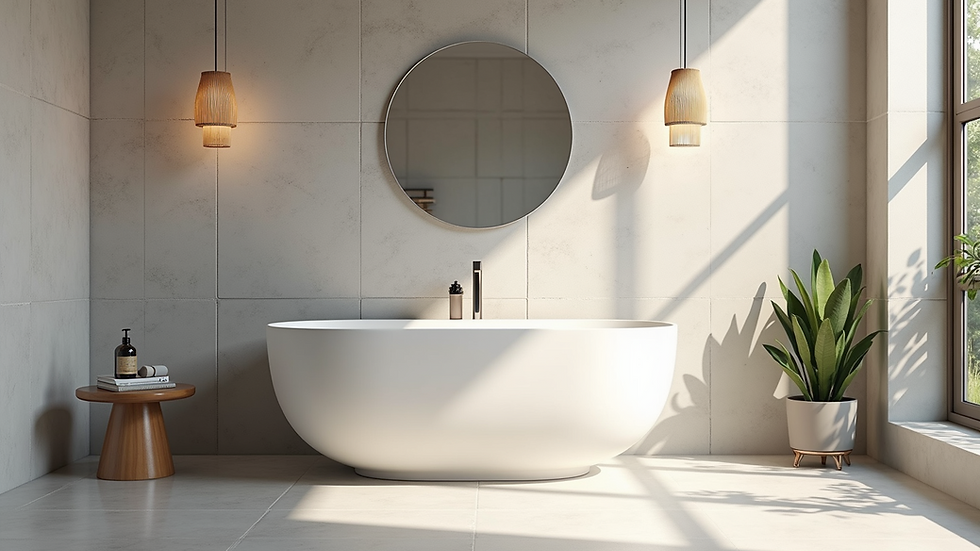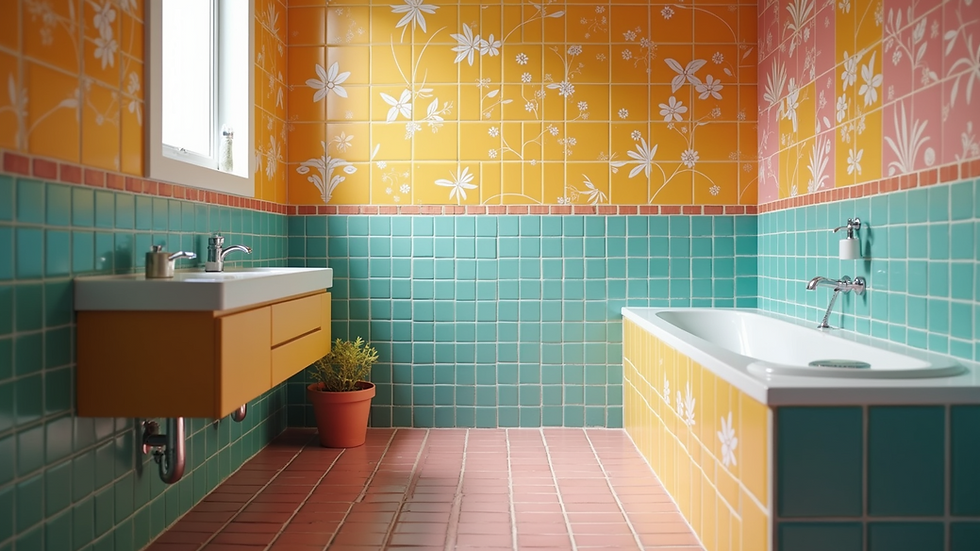Microcement vs Tiling for Your Bathroom Which is the Smart Choice for Your Remodel
- Ivy Redmond

- Jul 21
- 4 min read
Remodeling a bathroom is an exciting opportunity to refresh your home's aesthetic and functionality. One of the most critical decisions you’ll make is choosing the right flooring and wall finishes. Microcement and tiles are two popular options, each offering distinct benefits and challenges. This post explores what you should consider to make the best choice for your bathroom remodel.
Understanding Microcement
Microcement is gaining popularity due to its sleek design and versatile application. This cement-based coating can be applied over various surfaces, providing a seamless, modern finish. Available in numerous colors and textures, microcement suits styles ranging from industrial to minimalist.
A significant draw of microcement is its visually appealing surface. The clean, uninterrupted look can elevate any bathroom’s ambiance. This finish can create the illusion of a larger space, making it ideal for smaller rooms.
Pros of Microcement
Seamless Surface: Say goodbye to grout lines, which can be tough to clean. Microcement's smooth finish makes maintenance easy.
Durability: When installed correctly, microcement can resist wear and tear effectively. Many users report longevity, with some installations lasting over a decade.
Customizability: With a wide variety of colors and finishes, microcement allows you to create a unique look that reflects your personal style.
Waterproof Benefits: When properly sealed, microcement is waterproof, making it suitable for humid environments like bathrooms.
Cons of Microcement
Cracking Issues: Microcement can crack over time, particularly in areas with extreme temperature changes. Homeowners in climates like London should be aware of this risk.
Higher Labor Costs: The installation process can elevate costs. While materials may be cheaper, the expertise required can lead to higher overall expenses.
Requires Expertise: Professional installation is recommended to achieve the best results, adding to project time and costs.

The Appeal of Bathroom Tiling
Tiling has been a trusted choice among homeowners for many years. Tiles come in varied sizes, shapes, and materials, such as ceramic, porcelain, glass, and natural stone. This variety allows tiles to complement any design scheme, providing flexibility in aesthetic expression.
Pros of Tiling
Versatility: The options available are vast, from classic square tiles to unique mosaics. You can design a bathroom that matches your vision.
Easy Maintenance: Many tiles, especially ceramic and porcelain, are stain-resistant and easy to clean, making upkeep a breeze.
Heat Resistance: Tiles endure heat effectively, making them a good choice for areas near heating appliances like stoves.
Lower Cost of Material: Depending on your choices, tiles can often be more economical than microcement. Basic tiles may cost around $1 to $3 per square foot, while luxury options can soar to $15 or more.
Cons of Tiling
Grout Line Challenges: Grout can collect dirt and mold, requiring regular cleaning to maintain appearance.
Installation Complexity: Tiling can involve a lot of adhesive, increasing both cost and project time.
Less Seamless: Grout lines can interrupt the visual flow, which may make a space feel more cramped.

Cost Considerations
Cost is always a significant factor when choosing between microcement and tiles.
Microcement Costs
Typically, the material costs for microcement can be lower than high-end tiles. However, professional installation can be pricey. The labor-intensive nature of microcement installation often results in final costs that are substantially higher than those for tiling. For instance, labor costs can range from $10 to $20 per square foot, depending on the complexity and location.
Tiling Costs
Tile prices vary widely based on type and complexity. Basic ceramic tiles can start around $1 to $5 per square foot, while natural stone tiles might range from $5 to $25 or more. Installation labor may also vary, but it generally falls between $4 to $10 per square foot.
Functionality and Longevity
When deciding between microcement and tiles, it's vital to consider their functionality and durability.
Microcement Functionality
Microcement works well on floors, walls, and ceilings. Despite its appealing look, it can crack and wear in high-traffic areas. Regular maintenance, including periodic resealing, is necessary for optimal performance. When properly cared for, microcement can last between 10 to 15 years.
Tiling Functionality
Tiles offer excellent long-term durability when installed and maintained correctly. Quality tiles resist staining and scratching, making them particularly suited for wet areas. Grout lines need attention but do not significantly compromise the overall longevity of the tile. Many high-end tiles can last over 20 years, making them a sound investment.

Aesthetic Appeal
Your bathroom’s look can greatly influence the feel of your entire home.
Microcement Aesthetics
The sleek industrial look of microcement can bring modernity into your bathroom. Its smooth surface allows for creative designs that work well with other decor elements. Microcement's seamless nature can make small spaces feel more expansive.
Tiling Aesthetics
Tiles unlock countless design possibilities from rustic to elegant. Using different patterns and colors, you can achieve a wide range of aesthetics. They offer texture and character, enhancing the overall vibe of your bathroom.
Environmental Impact
With growing concerns about environmental sustainability, you may want to consider the eco-friendliness of your materials.
Microcement and the Environment
Made from natural materials, microcement is often more environmentally friendly than mass-produced tiles. Its durability may also lessen the need for replacements, making it a sustainable choice.
Tiling and the Environment
The impact of tiles varies by type. While ceramic tiles are generally eco-friendly, high-gloss tiles may include harmful chemicals. On the plus side, many durable tiles are designed for longevity, reducing environmental waste over time.
Making the Right Choice
In the end, the right choice between microcement and tiling will depend on your unique needs, budget, and design goals.
Choose Microcement if: You prefer a modern, seamless design, can invest in installation, and are willing to commit to regular maintenance.
Opt for Tiling if: You want a variety of aesthetic options, prefer a simpler installation process, and don’t mind taking care of grout.
Final Thoughts
Both microcement and tiling have unique advantages and drawbacks. Weighing their costs, functions, visual impacts, and long-term sustainability can guide you toward the best choice for your bathroom remodel. Remember that your selection will shape how you enjoy this essential space in the years ahead. Whether you lean toward the modern appeal of microcement or the classic charm of tiles, select a solution that fits your style and meets your practical needs.
In the end, your bathroom should be a sanctuary that looks great and functions perfectly. Happy remodeling!
.png)



Comments